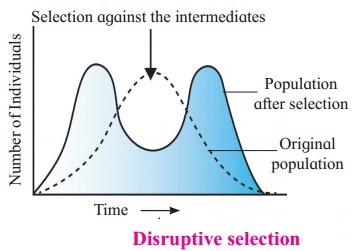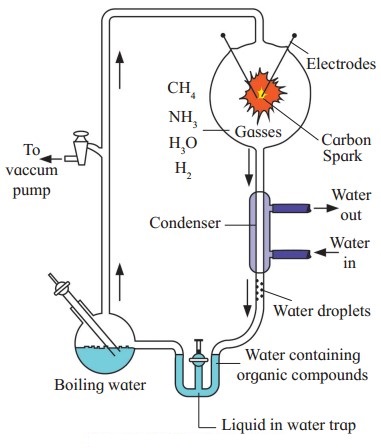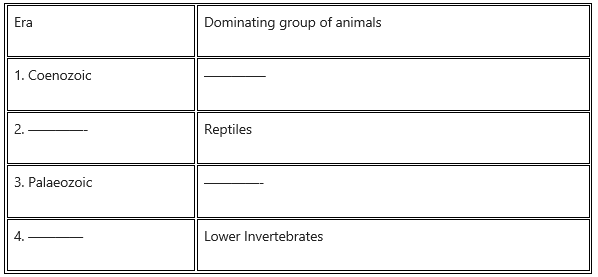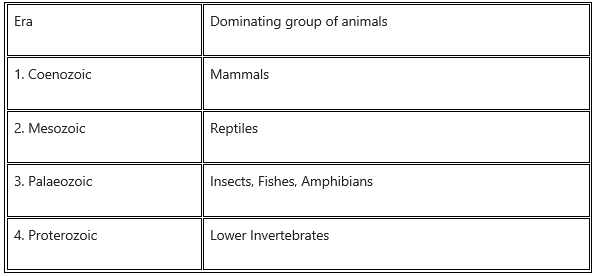Chapter 5 Origin and Evolution of Life
1. Multiple Choice Questions
Question 1.
Who proposed that the first form of life could have come from pre-existing non-living organic molecules?
(a) Alfred Wallace
(b) Oparin and Haldane
(c) Charles Darwin
(d) Louis Pasteur
Answer:
(b) Oparin and Haldane
Question 2.
The sequence of origin of life may be
(a) Organic materials – inorganic materials – Eobiont – colloidal aggregates – cell.
(b) Inorganic materials – organic materials – colloidal aggregates – Eobiont – cell.
(c) Organic materials – inorganic materials – colloidal aggregates – cell.
(d) Inorganic materials – organic materials – Eobiont – colloidal aggregates – cell.
Answer:
(b) Inorganic materials – organic materials- colloidal aggregates – Eobiont – cell.
Question 3.
In Hardy-Weinberg equation, the frequency of homozygous recessive individual is represented by-
(a) p²
(b) pq
(c) q²
(d) 2pq
Answer:
(c) q²
Question 4.
Select the analogous organs.
(a) Forelimbs of whale and bat
(b) Flippers of dolphins and penguin
(c) Thorn and tendrils of bougainvillea and Cucurbita
(d) Vertebrate hearts or brains
Answer:
(b) Flippers of dolphins and penguin
Question 5.
Archaeopteryx is known as missing link because it is a fossil and share characters of both
(a) Fishes and amphibians
(b) Annelida and Arthropoda
(c) Reptiles and birds
(d) Chordates and non-chordates
Answer:
(c) Reptiles and birds
Question 6.
Identify the wrong statement regarding evolution.
(a) Darwin’s variations are small and directional.
(b) Mutations are random and non- directional.
(c) Adaptive radiations leads to divergent evolution.
(d) Mutations are non-random and directional.
Answer:
(d) Mutations are non-random and directional
Question 7.
Gene frequency in a population remain constant due to ……………….
(a) Mutation
(b) Migration
(c) Random mating
(d) Non-random mating
Answer:
(c) Random mating
Question 8.
Which of the following characteristic is not : shown by the ape?
(a) Prognathous face
(b) Tail is present
(c) Chin is absent
(d) Forelimbs are longer than hind limbs
Answer:
(b) Tail is present
Question 9.
………………. can be considered as connecting link between ape and man.
(a) Australopithecus
(b) Homo habilis
(c) Homo erectus
(d) Neanderthal man
Answer:
(a) Australopithecus
Question 10.
The Cranial capacity of Neanderthal man was ……………….
(a) 600 cc
(b) 940 cc
(c) 1400 cc
(d) 1600 cc
Answer:
(c) 1400 cc
2. Very short answer questions
Question 1.
Define
(i) Gene pool
Answer:
The sum total of genes of all individuals of interbreeding population or Mendelian population is called gene pool.
(ii) Gene frequency
Answer:
The proportion of an allele in the gene pool as compared with other alleles at the same locus is termed as gene frequency.
(iii) Organic evolution
Answer:
Organic evolution can be defined as slow, gradual, continuous and irreversible changes through which the present-day complex forms of the life developed (or evolved) from their simple pre-existing forms.
(iv) Population
Answer:
All individuals of the same species form a group which is called a population.
(v) Speciation
Answer:
Formation of new species from the pre-existing single group of organisms is called speciation.
Question 2.
What is adaptive radiation?
Answer:
The process of evolution which results in transformation of original species to many different varieties is called adaptive radiation.
Question 3.
If the variation occurs in population by chance alone and not by natural selection and bring change in frequencies of an allele, what is it called?
Answer:
If the variation occurs in population by chance alone and not by natural selection to bring change in frequencies of an allele, it is called genetic drift.
Question 4.
State the Hardy-Weinberg equilibrium law.
Answer:
The Hardy-Weinberg equilibrium law states that at equilibrium point both the allelic frequency and genotypic frequency remain constant from generation to generation, in the diploid, sexually reproducing, large, free interbreeding population in which mating is random and there is absence of any other factors that change the allele frequency.
Question 5.
What is homologous organs?
Answer:
Homologous organs are those organs, which are structurally similar but perform different functions.
Question 6.
What is vestigial organ?
Answer:
Vestigial organs are imperfectly developed and non-functional organs which are in degenerate form, they may be functional in some related and other animals or in ancestor.
Question 7.
What is the scientific name of modern man?
Answer:
Homo sapiens sapiens is the scientific name of modern man.
Question 8.
What is coacervate?
Answer:
Coacervates are colloidal aggregations of hydrophobic proteins and lipids which grew in size by taking up material from surrounding aqueous medium.
Question 9.
Which period is known as ‘age of Reptilia’?
Answer:
Jurassic period from Mesozoic era is known as age of Reptilia.
Question 10.
Name the ancestor of human which is described as man with ape brain.
Answer:
Australopithecus, the ancestor of human which is described as man with ape brain.
Short Answer Questions
Question 1.
Genetic drift.
Answer:
- Genetic drift is random, directionless fluctuation that takes place in allele frequency.
- It occurs by pure chance, in small sized population.
- Genetic drift becomes an evolutional factor as it can change the gene frequency.
- Sewall wright has given this concept and hence it is also known as Sewall wright effect.
- Due to genetic drift, some alleles of a population are lost or reduced by chance and some others may be increased.
- Some time, a few individuals become isolated from the large population and they produce new population in new geographical area.
-
Genetic drift is also called founders’ effect because original drifted population becomes ‘founders’ in the new area.
E.g. Non-adaptive character of huge horns in Antelope is fixed due to genetic drift.
Question 2.
Enlist the different factors that are responsible for changing gene frequency.
Answer:
Gene flow, genetic drift, gene mutations, chromosomal aberrations such as deletion, duplication, inversion and translocation, genetic recombinations, natural selection, isolation are some of the factors which are responsible for changing the gene frequency.
Question 3.
Draw a graph to show that natural selection leads to disruptive change.
Answer:

Question 4.
Significance of fossils
Answer:
- Fossils are studied under palaeontology. They are used in reconstruction of phylogeny.
- Fossil study helps in studying various forms and structures of extinct animals.
- By understanding the structure of fossil, record of missing link between two groups of organisms can be deduced.
- By studying fossils various body forms and their evolution can be understood. They also help to understand the habit and habitat.
- Some fossils provide the evolutionary evidences such a connecting links.
Question 5.
Write the objections to Mutation theory of Hugo de Vries.
Answer:
Objections to Mutation Theory:
- Hugo de Vries observed the large and discontinuous variation. But these were chromosomal aberrations. Only gene mutations usually bring about minor changes.
- Rate by which mutations take place is very slow as compared to the requirement of evolution.
- Chromosomal aberrations are very unstable.
- The organisms with chromosomal aberration are usually sterile and thus chromosomal aberrations have little significance in evolution.
Question 6.
What is disruptive selection? Give example.
Answer:
Disruptive selection:
- The natural selection that disrupts the mean characters of the population, is called disruptive selection.
- Greater number of individuals acquire peripheral character value at both ends of the distribution curve. E.g. Finches with large size or small size, both will be selected.
- Extreme phenotypes are selected in evolutionary process and intermediate forms are eliminated.
- When distribution curve is plotted it shows two peaks for two extremes.
- Disruptive selection is rare because, nature always tries to balance the characters.
- It ensures the effect on the entire gene pool of a population, considering all mating types or systems.
Example of disruptive selection:
African seed cracker finches are types of seed-feeder birds which have different sizes of beak. The seeds available to them were of small and large sized. Large beak sized birds feeds on large seeds while small beak sized birds feed on small seeds.
Such large and small birds thus thrive well. However, intermediate beak sized birds are unable to feed on either type of seeds so they starve and their population was decreased gradually. Natural selection eliminated them and thus the population of finches appear disrupted.
4. Match the columns
Question 1.

Answer:

5. Long Answer Questions
Question 1.
Would you consider wings of butterfly and bat as homologous or analogous and why?
Answer:
Wings of butterfly are made up of chitin. They neither have bones, nor muscles in the wings. The bat’s wings are actually patagium. They have muscles and bones just as those seen in all vertebrate limb series. Therefore, these two examples cannot be homologous. However, both the animals use the wings for flight. This is an indication that their function is similar but structure is different, hence they are analogous organs.
Question 2.
What is adaptive radiation? Explain with suitable example.
Answer:
- Adaptive radiation is the process of evolution which results in transformation of original species to many different varieties.
- The well-known example of adaptive radiation is Darwin’s Finches. When Charles Darwin went on his voyage to Galapagos islands, he noticed finches which is a variety of small birds.
- According to Darwin’s observations, the American main land species of finches was the original one which must have migrated to the different islands of Galapagos.
- Since environmental conditions here were different, they adapted in various ways to the differing environmental conditions of these islands.
- Original bird had a beak suited for eating seeds, but the changed feeding pattern has changed the shape of beaks too. Some birds also show altered beaks for insectivorous mode. Thus, this demonstrated adaptive radiation.
- Adaptive radiation in Australian Marsupials is also well studied. In Australia, there are many marsupial mammals who evolved from common ancestor.
- Adaptive radiation leads to divergent evolution.
Question 3.
By talking industrial melanism as one example, explain the concept of natural selection.
OR
Explain natural selection in action by quoting the example of industrial melanism.
Answer:
1. Industrial melanism is the best example of natural selection which was studied by Kettlewell. In U.K. there are two varieties of peppered moths, Biston betularia and Biston carbonaria.
2. Before industrialisation, in Great Britain, Biston betularia were more in number than Biston carbonaria. B. Betularia is greyish white while B.carbonaria is melanic form.
3. These nocturnal moths rest on tree trunk during day. White-winged moth can camouflage well with the lichen covered whitish barks of trees. They thus escaped the attention of the predatory birds. But at the same time melanic forms were visible due to white barks of the trees. Their number was thus reduced as they were preyed upon by birds.
4. Later there was an industrial revolution, which ultimately resulted in air pollution causing dark soot to settle on the barks of the trees. Lichens too were destroyed and the melanic forms were now at advantage. Melanic forms could camouflage with black tree trunks and their number increased. White-winged moth become clearly seen in changed colours of the trees and thus they were easily caught by predatory birds. This caused decrease in their number.
5. Natural selection thus acted in changed environmental conditions and helped in the establishment of a phenotypic traits. The changed traits were more adaptive and hence were selected. Natural selection encourages those genes or traits that assure highest degree of adaptive efficiency between population and its environment.
Question 4.
Describe the Urey and Miller’s experiment.
Answer:

1. Urey and Miller performed an experiment to prove Oparin’s theory of chemical evolution.
2. They selected a spark discharge apparatus that consisted of closed system of glass having tungsten electrodes, flask for water boiling, a side tube connected to a vacuum pump, a cooling jacket and U-shaped trap.
3. The entire apparatus was first evacuated and made sterile and pre-biotic atmosphere was created in it.
4. The flask was filled with some water and mixture of methane, ammonia and hydrogen in the ratio of 1 : 2 : 2 were slowly passed through the stopcock, without allowing air.
5. Heat was supplied to the flask at very low temperature causing water to boil. The flask simulated the ocean present on primitive earth. Process of evaporation and precipitation was simulated by using heating mantle and condenser respectively.
6. Water vapours along with other gases were circulated continuously through continuous electric sparks. These sparks were given to the mixture for several days causing the gases to interact. This too simulated lightning.
7. Mixture of CH4, NH3 and H2 gases passed through a condenser and was condensed to liquid.
8. The liquefied mixture was collected in the U-shaped trap, present at the bottom of the apparatus. It was found that variety of simple organic compounds (urea, amino acids, lactic acid and sugars) were formed in the apparatus.
This experiment provides the evidence in support to the fact that simple molecules present in the earth’s early atmosphere combined to form the organic building blocks of life.
Question 5.
What is Isolation? Describe the different types of reproductive isolations.
Answer:
1. Isolation means separation of the population of a particular species into smaller units. The organisms belonging to these subunits are prevented from interbreeding due to some barrier. These barriers are called isolating mechanisms.
2. They prevent the genetic exchange and gene flow.
3. Due to isolating mechanisms in nature the divergence among organisms takes place gradually leading to speciation. The isolating mechanisms are of two types namely, geographical isolation and reproductive isolation.
I. Geographical Isolation : The barrier in the form of physical distance or geographical barrier is called geographical isolation. The original population gets divided into two or more groups by geographical barriers such as river, ocean, mountain, glacier, etc. Organisms cannot cross the barriers on their own and hence interbreeding is prevented between isolated groups.
The separated groups experience different environmental factors and they acquire new traits by mutations. The separated populations develop distinct gene pool and they do not interbreed. Each subgroup then evolves differently which results into formation of new species. E.g. Darwin’s Finches, African elephant, Loxodonta and Indian elephant, Elephas.
II. Reproductive Isolation : Two populations may be occupying the same area, they may not be separated by geographical barrier, but then also they are reproductively isolated. Such reproductive isolation occurs due to change in genetic material, gene pool and structure of genital organs. Such differences prevent interbreeding between population. Such isolation later leads to speciation.
III. Different types of reproductive isolations : Reproductive isolation is of two types, viz. pre-zygotic and post-zygotic isolating mechanisms.
- Pre-zygotic or pre-mating isolating mechanisms do not allow individuals to mate with each other at all.
- By various mechanisms the two groups remain isolated.
- In post-zygotic or post-mating isolating mechanisms, the two individuals can mate but the result of mating is not favourable.
- Thus the populations remain isolated without the actual genetic exchange.
Question 6.
What is Genetic variations? Explain the different factors responsible for genetic variations.
Answer:
Genetic variations : The change in gene and gene frequencies is known as genetic variation. Genetic variations are caused by following factors:
(i) Mutations : Sudden permanent heritable change is called mutation. Mutation can occur in the gene, in the chromosome structure and in chromosome number. Mutation that occurs within the single gene is called point mutation or gene mutation. This leads to the change in the phenotype of the organism, causing variations.
(ii) Genetic recombination : In sexually reproducing organisms, during gamete formation, exchange of genetic material occurs between non-sister chromatids of homologous chromosomes. This is called crossing over. It produces new genetic combinations which result in variation. Fertilization between opposite mating gametes leads to various recombinations resulting into the phenotypic variations. These result in change in the frequencies of alleles.
(iii) Gene flow : Gene flow is movement of genes into or out of a population. Gene movement may be in the form of migration of organism, or gametes (dispersal of pollens) or segments of DNA (transformation). Gene flow also alters gene frequency causing evolutionary changes.
(iv) Genetic drift : Any random fluctuation (alteration) in allele frequency, occurring in the natural population by pure chance, is called genetic drift. For example, when the size of a population is severely reduced due to natural disasters like earthquakes, floods, fires, etc. elimination of particular alleles from a population becomes possible. Smaller populations have greater chances for genetic drift. It results in the change in the gene frequency. Genetic drift is also an important factor for evolutionary change.
(v) Chromosomal aberrations : The structural, morphological change in chromosome due to rearrangement of genes is called chromosomal aberrations. Due to changes in the gene arrangement or gene sequence variations are caused.
6. Complete the chart

Answer:
